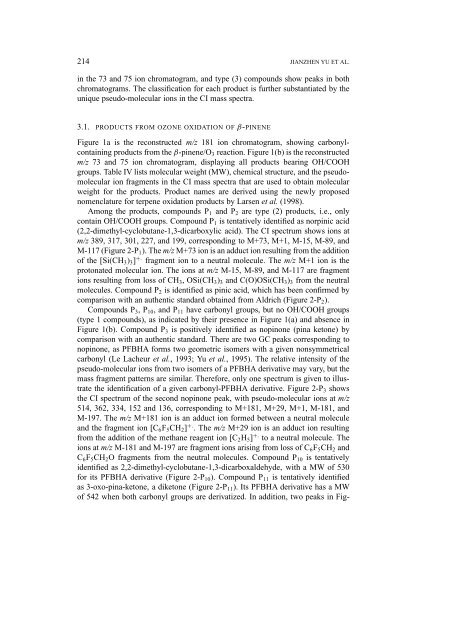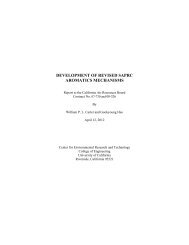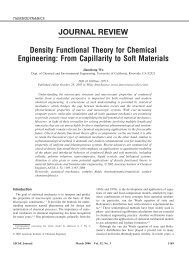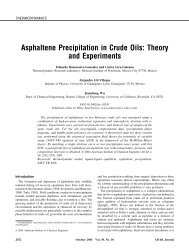Gas-Phase Ozone Oxidation of Monoterpenes: Gaseous and ...
Gas-Phase Ozone Oxidation of Monoterpenes: Gaseous and ...
Gas-Phase Ozone Oxidation of Monoterpenes: Gaseous and ...
Create successful ePaper yourself
Turn your PDF publications into a flip-book with our unique Google optimized e-Paper software.
214 JIANZHEN YU ET AL.<br />
in the 73 <strong>and</strong> 75 ion chromatogram, <strong>and</strong> type (3) compounds show peaks in both<br />
chromatograms. The classification for each product is further substantiated by the<br />
unique pseudo-molecular ions in the CI mass spectra.<br />
3.1. PRODUCTS FROM OZONE OXIDATION OF β-PINENE<br />
Figure 1a is the reconstructed m/z 181 ion chromatogram, showing carbonylcontaining<br />
products from the β-pinene/O 3 reaction. Figure 1(b) is the reconstructed<br />
m/z 73 <strong>and</strong> 75 ion chromatogram, displaying all products bearing OH/COOH<br />
groups. Table IV lists molecular weight (MW), chemical structure, <strong>and</strong> the pseudomolecular<br />
ion fragments in the CI mass spectra that are used to obtain molecular<br />
weight for the products. Product names are derived using the newly proposed<br />
nomenclature for terpene oxidation products by Larsen et al. (1998).<br />
Among the products, compounds P 1 <strong>and</strong> P 2 are type (2) products, i.e., only<br />
contain OH/COOH groups. Compound P 1 is tentatively identified as norpinic acid<br />
(2,2-dimethyl-cyclobutane-1,3-dicarboxylic acid). The CI spectrum shows ions at<br />
m/z 389, 317, 301, 227, <strong>and</strong> 199, corresponding to M+73, M+1, M-15, M-89, <strong>and</strong><br />
M-117 (Figure 2-P 1 ). The m/z M+73 ion is an adduct ion resulting from the addition<br />
<strong>of</strong> the [Si(CH 3 ) 3 ] +. fragment ion to a neutral molecule. The m/z M+1 ion is the<br />
protonated molecular ion. The ions at m/z M-15, M-89, <strong>and</strong> M-117 are fragment<br />
ions resulting from loss <strong>of</strong> CH 3 , OSi(CH 3 ) 3 <strong>and</strong> C(O)OSi(CH 3 ) 3 from the neutral<br />
molecules. Compound P 2 is identified as pinic acid, which has been confirmed by<br />
comparison with an authentic st<strong>and</strong>ard obtained from Aldrich (Figure 2-P 2 ).<br />
Compounds P 3 ,P 10 ,<strong>and</strong>P 11 have carbonyl groups, but no OH/COOH groups<br />
(type 1 compounds), as indicated by their presence in Figure 1(a) <strong>and</strong> absence in<br />
Figure 1(b). Compound P 3 is positively identified as nopinone (pina ketone) by<br />
comparison with an authentic st<strong>and</strong>ard. There are two GC peaks corresponding to<br />
nopinone, as PFBHA forms two geometric isomers with a given nonsymmetrical<br />
carbonyl (Le Lacheur et al., 1993; Yu et al., 1995). The relative intensity <strong>of</strong> the<br />
pseudo-molecular ions from two isomers <strong>of</strong> a PFBHA derivative may vary, but the<br />
mass fragment patterns are similar. Therefore, only one spectrum is given to illustrate<br />
the identification <strong>of</strong> a given carbonyl-PFBHA derivative. Figure 2-P 3 shows<br />
the CI spectrum <strong>of</strong> the second nopinone peak, with pseudo-molecular ions at m/z<br />
514, 362, 334, 152 <strong>and</strong> 136, corresponding to M+181, M+29, M+1, M-181, <strong>and</strong><br />
M-197. The m/z M+181 ion is an adduct ion formed between a neutral molecule<br />
<strong>and</strong> the fragment ion [C 6 F 5 CH 2 ] +. .Them/z M+29 ion is an adduct ion resulting<br />
from the addition <strong>of</strong> the methane reagent ion [C 2 H 5 ] +. to a neutral molecule. The<br />
ions at m/z M-181 <strong>and</strong> M-197 are fragment ions arising from loss <strong>of</strong> C 6 F 5 CH 2 <strong>and</strong><br />
C 6 F 5 CH 2 O fragments from the neutral molecules. Compound P 10 is tentatively<br />
identified as 2,2-dimethyl-cyclobutane-1,3-dicarboxaldehyde, with a MW <strong>of</strong> 530<br />
for its PFBHA derivative (Figure 2-P 10 ). Compound P 11 is tentatively identified<br />
as 3-oxo-pina-ketone, a diketone (Figure 2-P 11 ). Its PFBHA derivative has a MW<br />
<strong>of</strong> 542 when both carbonyl groups are derivatized. In addition, two peaks in Fig-
















